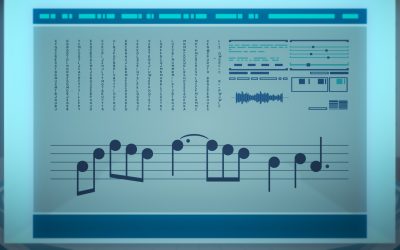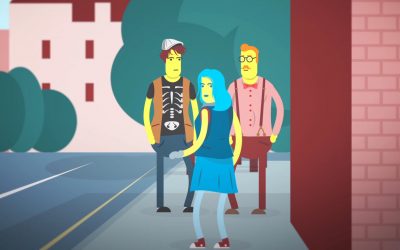29. THE DOUBLE SCORE
In The Missing Note, the key to a cipher is contained in the recording of part of a film soundtrack. In Case File #28, we considered how copyright protects music and sound recordings – two different categories of copyright work. In this Case File #29 we consider these types of copyright works in more detail, with a view to exploring the different kinds of permission one may need when making use of someone else’s music in a film or video.
OWNERS PERMITTING
As we have seen in Case File #28, melodies and lyrics are treated as two different types of copyright work: melodies are musical works, whereas lyrics are literary works. In addition, sound recordings are protected separately and have a different copyright term.
If you wish to use a song in a film you are creating, you may need permission from different rightsholders depending on the type of use you intend to make. For example, if you wish to create your own version of an existing composition, you need to identify who owns copyright in that melody and get their permission. Copyright in a melody belongs to the person(s) who created it, unless they assigned (all or some of) their rights to a music publisher (which is often the case).
The same is true for lyrics: the writer owns copyright in the lyrics, if she has not assigned it to a third party. So, if you are writing a script and want to use existing lyrics, you need to identify the copyright owners of those lyrics and get their permission, unless your use is covered by a copyright exception such as quotation or parody.
If you intend to use an existing sound recording in a film, video game, advert or other audiovisual production, you need multiple permissions from different rightsholders: permission to use the melody embedded in the recording from the people who composed it and/or their music publishers; as well as permission to use the recording from its producer (usually a record label). Using recorded music in moving images is known as ‘synchronisation’, and the process to get permission to do so lawfully as ‘sync licensing’. Sync licensing fees can be negotiated directly with the rightsholders of the sound recording and the music embedded in it or with specialist ‘sync’ companies who act on their behalf. You can find practical information on how to get sync licences on the PRS for Music website: https://www.prsformusic.com/licences/releasing-music-products/commercial-music-sync-licensing
As a film producer you may also try to secure an assignment of rights (rather than a licence) from the song’s rightsholders, although this is likely to be more difficult and costlier. For more information about the differences between licences and assignments, see Case File #12.
COPYRIGHT AND FILM SOUNDTRACKS
When the Copyright Designs and Patents Act (CDPA) was first enacted in 1988, a sound recording was defined to mean a ‘recording of sounds’ or ‘of the whole or any part of a literary, dramatic or musical work’ from which the sounds may be reproduced, regardless of the medium of recording or the method of reproducing the sounds (s.5(1)). Within the same section, a film was defined as ‘a recording on any medium from which a moving image may by any means be produced’ (s.5(1)). As such, it was generally accepted that a film soundtrack was distinct from the film itself. That is, these were two different works attracting copyright protection separately: copyright in the film, and copyright in the film soundtrack as a sound recording.
On 1 January 1996, the CDPA was amended to bring into force a European Directive on the term of protection of copyright and related rights (the 1993 Term Directive). With the implementation of the Term Directive, the status of film soundtracks changed. Now, the CDPA provides that ‘the sound track accompanying a film shall be treated as part of the film’ (s.5B(2)). But, in addition, the revised CDPA clarified that this did not affect ‘any copyright subsisting in a film sound track as a sound recording’ (s.5B(5)). In other words, copyright now exists in a soundtrack both as part of a film and separately as a sound recording.
This change adds an additional layer of complexity to calculating the duration of copyright in film soundtracks. This is because duration of copyright in a film is different from duration in a sound recording.
Copyright in a film is calculated in accordance with the last to die of four specifically designated persons: the director, the author of the screenplay, the author of the film dialogue (if different), and the composer of the film score (s.13B(2)). By contrast, copyright in a sound recording expires 50 years from the end of the year in which the recording is made, unless, during that period, the recording is published or made available to the public, in which case copyright expires 70 years from the end of the year in which it was published or made available (s.13A(2)).
In short, different copyright terms apply to films and to sound recordings. In practice, this means that when dealing with the soundtrack as an integral part of a film, duration is calculated by reference to the rules on film copyright. On the other hand, when dealing with a film soundtrack separate from the film itself (for example, when the soundtrack is released on a CD or other format) copyright is calculated by reference to the rules on sound recordings.
This same logic applies to the use of film soundtracks. For example, if you have permission to show a film in public this necessarily includes the film soundtrack. That is, you do not have to get separate permission to play the soundtrack in public when showing the film. The film and the soundtrack are treated as one and the same for this purpose.
FOR DISCUSSION: I WILL (NOT) ALWAYS LICENSE YOU
The song ‘I Will Always Love You’ was originally written and recorded in 1973 by American singer-songwriter Dolly Parton, who released her famous country version of the song in 1974 as a single. The song reached number one on the Billboard Hot Country Songs chart twice: first in June 1974, and then in October 1982, when Parton re-recorded the song for the film The Best Little Whorehouse in Texas. When the 1974 recording of the song was reaching number one on the country charts, Elvis Presley indicated that he wanted to cover the song. However, since Elvis’ managers requested the assignment of part of her publishing rights in the song, Parton refused. In 1992, Whitney Houston recorded her version of the song for the film The Bodyguard. The Bodyguard remains the best-selling soundtrack album of all time, selling over 42 million copies worldwide. In 1995, Parton recorded a third version of her song with Vince Gill as a duet.
How many copyright works can you identify in this story? Why do you think Dolly Parton gave permission to Whitney Houston and not to Elvis Presley to cover her song?
USEFUL REFERENCES:
Copyright Designs and Patents Act 1988: http://www.legislation.gov.uk/ukpga/1988/48/contents
For an innovative and accessible resource on music copyright, see Going for a Song: https://www.copyrightuser.org/create/creative-process/going-for-a-song/
For further information on copyright duration in the UK, see Copyright Bite #1 – Copyright Duration: https://www.copyrightuser.org/copyright-bites/1-copyright-duration/
See also: Copyright and Digital Cultural Heritage: Duration of Copyright: https://copyrightcortex.org/copyright-101/chapter-6
Download the PDF version of Case File #12 – The Hollywoodland Deal
Download the PDF version of Case File #28 – The Musician and the Machine
Download the PDF version of Case File #29 – The Double Score
More Case Files
28. The Musician and the Machine
In this Case File #28, we consider how copyright protects music and sound recordings – two different categories of copyright work.
30. The Creative Copy
In this Case File #30, we consider the concept of self-plagiarism and how it relates to creativity and copyright.










